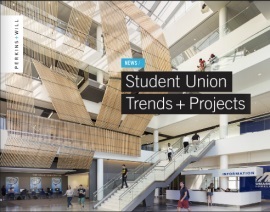
by Brianna Crandall — November 26, 2014—Interdisciplinary architecture and design firm Perkins+Will has completed seven higher education student union projects across the United States and Canada since January 2014. This experience, plus the firm’s “unprecedented” total of 50 student union projects, its long-term client engagement, and in-depth research, has enabled Perkins+Will’s higher education practice to predict four trends related to student unions, listed below.
Project delivery through public/private partnerships (P3)
The delivery of projects through public/private partnerships is on the rise. At the University of Alaska Fairbanks, the university was able to fund its project by creating a partnership with the architect, contractor, developer, and a nonprofit organization that sold bonds to finance the project. P3 offers the ability to deliver a public project through a private delivery process that is more time- and cost-efficient than a typical public process. In the P3 process, the project team is motivated by cost guarantees and incentives to deliver the project in a shorter timeframe that results in cost savings without compromising quality.
A hub that unites with “the spaces between”
Education does not simply happen in the classroom or lab—it is an integrated experience that happens as students interact in the hallway, dining hall, auditorium, meeting room, and fitness center. Student union projects are being designed for the future, focusing on these “spaces between” that increase the potential for spontaneous interactions that are fundamental to a holistic education. P+W believes that a “high tech” learning environment will never completely replace the “high touch” academic experience.
Diversity is central to the student experience
Often placed in disparate locations, diversity programs at universities are now central to student life. At the Colorado State University, Lory Student Center, the cultural richness of the school’s diversity programs is visibly seen at the entrance through the shared commons, customized office doors, and displays of heritage art. The prominence of the diversity programs and services signals a paradigm shift in the importance of diversity on campus.
Demand for more sustainable buildings
Tomorrow’s buildings will generate more power than they consume, harvest more water than they use, and will become inseparably connected with their ecosystems. At the Case Western Reserve University, Tinkham Veale University Center, an innovative glass curtainwall was designed to address solar heat gain and a green roof, including photovoltaic panels, was central to the design, integrating the building with nature both visually and physically.
Perkins+Will’s extensive portfolio of recent work represents designs for public and private institutions of higher education in Alaska, California, Colorado, Illinois, Massachusetts, Ohio, and Ontario. The seven most recent projects were:
- Case Western Reserve University, Tinkham Veale University Center, Cleveland, OH
- Colorado State University, Lory Student Center, Fort Collins, CO
- Kings University College, Student Life Centre, London, ON, Canada
- Parkland College, Student Union, Champaign, IL
- San Jose State University, Student Union, San Jose, CA
- University of Alaska Fairbanks, Wood Center, Fairbanks, AL
- University of Massachusetts Lowell, University Crossing, Lowell, MA
Perkins+Will compiled the trends along with snapshots of each of its most recent projects in the publication Student Union Trends + Projects, available through the firm’s Web site.





